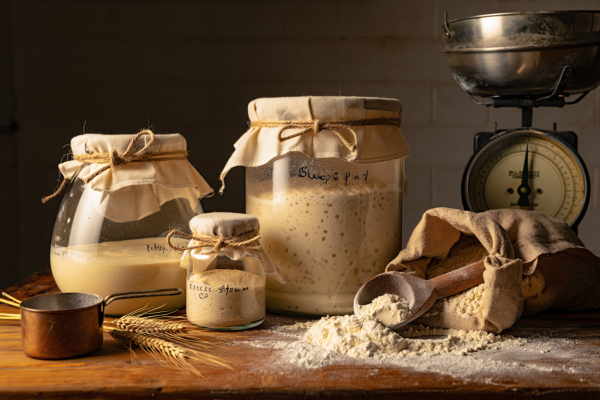
Sourdough Starters: What Fermentation Reveals About Timing, Balance, and Investing
Updated Aug 29, 2025
Introduction: Patience, Fermentation, and the Calm Hand
There’s something elemental about sourdough. No commercial yeast. No shortcuts. Just flour, water, air, and time. A starter is alive—you don’t simply bake with it, you raise it. You feed, wait, observe, worry a little, mutter under your breath, and return. It bubbles on its own schedule, not yours.
It’s slow. It can be temperamental. And it’s exactly the lesson today’s hurried investor doesn’t want to hear.
If you can’t wait for a loaf to rise, what makes you think you’ll stay the course through a multi‑year investment cycle?
This isn’t merely baking; it’s portfolio discipline in disguise—rustic fermentation as a master class in timing, patience, and letting compounding do its quiet work.
Lesson 1: You Don’t Control the Timeline—The Culture Does
The first thing every novice baker learns about sourdough: you are not in charge. You mix flour and water and leave it exposed to the air, praying the wild yeasts show up. The starter is born when it’s born. Not before. Not because you want it.
That’s the market.
You can research, chart, and theorise. But the macro forces—sentiment, liquidity, mass emotion—those are wild yeasts. You invite them. You don’t command them.
Buy a fundamentally sound company in 2022, and it might tank for two years. Your timing matters little to the market’s internal fermentation process.
Control is an illusion. You cultivate conditions, then wait for the bubble.
Lesson 2: Most People Kill the Starter—Because They Can’t Handle the Waiting
Here’s the truth: most people who try to make sourdough fail in the first five days. Why? Because it looks dead. Nothing happens. Then something smells weird. Then the mould shows up. Panic. They toss it.
But what seasoned bakers know? That’s part of the process. Starters always get ugly before they stabilise. They smell like socks. They flatten out. They sulk in their jars like depressed pets. And then—boom. Day six. Bubbles. Life. Growth.
Investors are the same. The first 6 months of a new strategy? Doubt, second-guessing, portfolio rot. You cut the position. Or worse, you dump the whole strategy and chase another guru.
The elite? They stick through the smell.
Lesson 3: Mass Psychology is Mould
Want to ruin your starter? Leave it open in a contaminated environment. Mould wins every time.
Markets are no different. The moment you leave your investing process open to the “experts,” the headlines, the Twitter charts, the CNBC cries—it infects your thinking.
Your starter gets fuzzy. Your conviction collapses. Suddenly, you’re not even feeding your dough with your own hands—you’re crowd-sourcing it with opinions that haven’t earned a dollar in years.
Mould doesn’t make noise. It whispers. “You’re doing it wrong.” “That bubble isn’t real.” “Dump it now.” And before you know it, the batch is in the trash.
Protect your fermentation space. Filter your inputs. Think in silence.
Lesson 4: Feeding It Is Not the Same as Fiddling With It
A good sourdough starter doesn’t need constant attention. It just needs consistency. Feed it, leave it alone. Come back later. Over-fiddle, and you ruin it.
Investors? We’re tinkerers by trauma. We can’t stop checking, adjusting, and second-guessing. We equate action with intelligence.
But the best gains come from feeding good ideas and letting them breathe. We should not adjust stop-losses daily, over-trade, or rebalance every 48 hours because some guy on YouTube screamed, “liquidity crunch.”
The dough doesn’t rise faster just because you stare at it harder. And neither does your portfolio.
The Starter Is You
Here’s the part no one tells you: the sourdough starter isn’t just your bread base. It’s a mirror.
How you treat it says everything about your risk tolerance, your patience, and our discipline. You are feeding a living thing that reflects your internal state. If you’re chaotic, your starter will collapse. If you’re scared, you’ll kill it. If you’re arrogant, you’ll rush it—and blow it.
Same in investing.
Markets don’t just reveal your strategy. They reveal your psyche. And that’s where mass psychology really gets exposed—not in the crowd, but in the cracks in your own discipline.
You don’t beat the market. You stabilise yourself.
When the Dough Collapses—Embrace the Slack
Every baker knows the heartbreak of a collapsed dough. It was rising. It looked good. And then—pancake. Flat. Slack. No oven spring.
Guess what?
Markets do that too. The stock you loved dips 40%. Your macro thesis hits a brick wall. A black swan shatters your liquidity buffer. Suddenly, your starter is bleeding.
This is where the amateurs cry and reset. But the battle-hardened? They rebuild with what’s left. Sourdough isn’t about avoiding collapse—it’s about recognising that collapse is built in. The slack dough isn’t dead. It’s a signal. Adjust your hydration. Lower the proofing time. Change the ambient temp.
Investors call it risk management. Bakers call it intuitive baking. Either way, it’s survival.
Recipe: The Market-Warrior’s Sourdough Starter
Want the real stuff? Here’s a no-bullshit recipe that builds your starter from scratch, just like a real investor builds conviction.
Ingredients:
- 60g whole wheat flour (day one volatility—raw and unpredictable)
- 60g lukewarm filtered water (liquidity—essential, but don’t drown it)
Tools:
- A glass jar
- A rubber band
- A nose (yes, you’ll need to smell this thing daily)
- Patience (if you’re short on this, stop reading and go trade meme stocks)
Instructions:
Day 1: Mix flour and water. Stir aggressively. Leave in a warm spot uncovered for an hour, then cover loosely. Walk away.
Day 2–3: Check for bubbles. Stir once or twice if you see nothing—good. It’s working. Don’t feed it yet.
Day 4: Start feeding. Discard half. Add 60g of flour and 60g of water. Stir. A rubber band marks the level.
Day 5–6: Should be active now—doubling in 6 hours or less. If not, keep feeding daily. Don’t get fancy. Don’t add honey or cheat with commercial yeast.
Day 7–10: Mature. Stable. Bubbly. Smells sharp but clean. This is your bread base. And your psychological baseline.
Feed it daily if on the counter. Once a week if refrigerated. Forever.
Intuition, Pattern Recognition, and the Scent of Readiness
The moment your starter is ready, you’ll know. It floats. It smells like apples and vinegar. It bubbles rhythmically. There’s no timer. No alert.
Just like the market.
True entry points don’t flash neon signs. They smell right. They feel electric. But that intuition isn’t magic—it’s earned pattern recognition from hundreds of false starts, misreads, and watching the dough not rise.
The greatest investors know this. They don’t always explain why they pulled the trigger. But ask them what they saw, and you’ll hear: “The tone shifted. The smell changed. The crowd forgot something fundamental.”
That’s sourdough intuition. That’s market mastery.
Final Thoughts: The Loaf is Not the Goal
Here’s the final truth: the perfect loaf isn’t the point.
You might bake 100 loaves in a year. Some great. Some mediocre. A few tragic. But it’s the practice, the repetition, the quiet daily feedings that build something deeper.
Investing is the same. The portfolio isn’t the point. It’s the discipline, the emotional hygiene, the detachment from the outcome, and the commitment to the process.
Whether it’s dough or dollars, the real reward is becoming the kind of person who can raise a starter and hold a position—without flinching.
Because in the end, the market and the dough will do what they do.
The only question is whether you stay stable enough to let them rise.
Leaving a Mark: Impactful Articles












